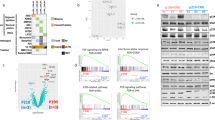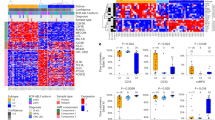Abstract
Imatinib is highly effective in newly diagnosed, but not in relapsed, Philadelphia chromosome positive acute lymphoblastic leukemia (Ph+ ALL). BCR-ABL tyrosine kinase domain (TKD) mutations are associated with acquired imatinib resistance, but their role in primary resistance is uncertain. Using highly sensitive ligation-PCR and denaturing high-performance liquid chromatography (DHPLC), we identified baseline TKD mutations in 21% and 42% of imatinib-naïve patients with newly diagnosed (n=26) or recurrent (n=65) Ph+ ALL, respectively (P=ns). Within 4 weeks of starting the imatinib treatment, absolute levels of mutant bcr-abl transcripts increased significantly in patients with advanced, but not with de novo, Ph+ ALL. The net expansion of pre-existing mutant clones during imatinib treatment resulted in the rapid appearance of initially undetectable TKD mutations, which after 4 weeks were detectable in 70% of patients with advanced disease. There was a high degree of concordance between the type of mutations detected at relapse and during initial imatinib treatment. The profoundly different outgrowth dynamics of leukemic clones with bcr-abl mutations in imatinib-treated patients who differ in their disease history, provides clinical–translational evidence for a contributory role of non-mutational resistance mechanisms, possibly induced by prior chemotherapy. Moreover, the prevalence of pre-existing, clinically relevant TKD may have been underestimated in tyrosine kinase inhibitor-naïve patients with Ph+ ALL.
This is a preview of subscription content, access via your institution
Access options
Subscribe to this journal
Receive 12 print issues and online access
$259.00 per year
only $21.58 per issue
Buy this article
- Purchase on Springer Link
- Instant access to full article PDF
Prices may be subject to local taxes which are calculated during checkout






Similar content being viewed by others
References
Vignetti M, Fazi P, Cimino G, Martinelli G, Di Raimondo F, Ferrara F et al. Imatinib plus steroids induces complete remissions and prolonged survival in elderly Philadelphia chromosome-positive acute lymphoblastic leukemia patients without additional chemotherapy: results of the Gruppo Italiano Malattie Ematologiche dell’Adulto (GIMEMA) LAL0201-B protocol. Blood 2007; 109: 3676–3688.
Ottmann OG, Wassmann B, Pfeifer H, Giagounidis A, Stelljes M, Dührsen U et al. Imatinib compared with Chemotherapy as Front-Line Treatment of Elderly Patients with Philadelphia Chromosome positive Acute Lymphoblastic Leukemia (Ph+ ALL). Cancer 2007; 109: 2068–2076.
Thomas DA, Faderl S, Cortes J, O’Brien S, Giles FJ, Kornblau SM et al. Treatment of Philadelphia chromosome-positive acute lymphocytic leukemia with hyper-CVAD and imatinib mesylate. Blood 2004; 103: 4396–4407.
Lee KH, Lee JH, Choi SJ, Lee JH, Seol M, Lee YS et al. Clinical effect of imatinib added to intensive combination chemotherapy for newly diagnosed Philadelphia chromosome-positive acute lymphoblastic leukemia. Leukemia 2005; 19: 1509–1516.
Yanada M, Takeuchi J, Sugiura I, Akiyama H, Usui N, Yagasaki F et al. High complete remission rate and promising outcome by combination of imatinib and chemotherapy for newly diagnosed BCR-ABL-positive acute lymphoblastic leukemia: a phase II study by the Japan Adult Leukemia Study Group. J Clin Oncol 2006; 24: 460–466.
Wassmann B, Pfeifer H, Goekbuget N, Beelen DW, Beck J, Stelljes M et al. Alternating versus concurrent schedules of imatinib and chemotherapy as front-line therapy for Philadelphia-positive acute lymphoblastic leukemia (Ph+ ALL). Blood 2006; 108: 1469–1477.
Druker BJ, Sawyers CL, Kantarjian H, Resta DJ, Reese SF, Ford JM et al. Activity of a specific inhibitor of the BCR-ABL tyrosine kinase in the blast crisis of chronic myeloid leukemia and acute lymphoblastic leukemia with the Philadelphia chromosome. N Engl J Med 2001; 344: 1038–1042.
Ottmann OG, Druker BJ, Sawyers CL, Goldman JM, Reiffers J, Silver RT et al. A phase 2 study of imatinib in patients with relapsed or refractory Philadelphia chromosome-positive acute lymphoid leukemias. Blood 2002; 100: 1965–1971.
Wassmann B, Pfeifer H, Scheuring UJ, Binckebanck A, Gökbuget N, Atta J et al. Early prediction of response in patients with relapsed or refractory Philadelphia-chromosome positive acute lymphoblastic leukemia (Ph+ ALL) treated with imatinib mesylate (Glivec). Blood 2004; 103: 1495–1498.
de Labarthe A, Rousselot P, Huguet-Rigal F, Delabesse E, Witz F, Maury S et al. Group for Research on Adult Acute Lymphoblastic Leukemia (GRAALL). Imatinib combined with induction or consolidation chemotherapy in patients with de novo Philadelphia chromosome-positive acute lymphoblastic leukemia: results of the GRAAPH-2003 study. Blood 2007; 109: 1408–1413.
Delannoy A, Delabesse E, Lheritier V, Castaigne S, Rigal-Huguet F, Raffoux E et al. Imatinib and methylprednisolone alternated with chemotherapy improve the outcome of elderly patients with Philadelphia-positive acute lymphoblastic leukemia: results of the GRAALL AFR09 study. Leukemia 2006; 20: 1526–1532.
Hofmann WK, Jones LC, Lemp NA, de Vos S, Gschaidmeier H, Hoelzer D et al. Ph(+) acute lymphoblastic leukemia resistant to the tyrosine kinase inhibitor STI571 has a unique BCR-ABL gene mutation. Blood 2002; 99: 1860–1862.
von Bubnoff N, Schneller F, Peschel C, Duyster J . BCR-ABL gene mutations in relation to clinical resistance of Philadelphia-chromosome-positive leukaemia to STI571: a prospective study. Lancet 2002; 359: 487–491.
Jones D, Thomas D, Yin CC, O’Brien S, Cortes JE, Jabbour E et al. Kinase domain point mutations in Philadelphia Chromosome positive acute lymphoblastic leukemia emerge after therapy with bcr-abl kinase inhibitors. Cancer 2008; 113: 985–994.
Branford S, Rudzki Z, Walsh S, Parkinson I, Grigg A, Szer J et al. High frequency of point mutations clustered within the adenosine triphosphate-binding region of BCR/ABL in patients with chronic myeloid leukemia or Ph-positive acute lymphoblastic leukemia who develop imatinib (STI571) resistance. Blood 2002; 99: 3472–3475.
Pfeifer H, Wassmann B, Pavlova A, Wunderle L, Oldenburg J, Binckebanck A et al. Kinase domain mutations of BCR-ABL frequently precede imatinib-based therapy and give rise to relapse in patients with de novo Philadelphia-positive acute lymphoblastic leukemia (Ph+ ALL). Blood 2007; 110: 727–734.
Soverini S, Colarossi S, Gnani A, Rosti G, Castagnetti F, Poerio A et al. Contribution of ABL Kinase domain mutations to imatinib resistance in different subsets of Philadelphia-positive patients. Clin Cancer Res 2006; 12: 7374–7379.
Hofmann WK, Komor M, Wassmann B, Jones LC, Gschaidmeier H, Hoelzer D et al. Presence of the BCR-ABL mutation Glu255Lys prior to STI571 (imatinib) treatment in patients with Ph+ acute lymphoblastic leukemia. Blood 2003; 102: 659–661.
Soverini S, Vitale A, Poerio A, Gnani A, Colarossi S, Iacobucci I et al. Philadelphia-positive acute lymphoblastic leukemia patients already harbor BCR-ABL kinase domain mutations at low levels at the time of diagnosis. Haematologica 2011; 96: 552–557.
Griswold IJ, MacPartlin M, Bumm T, Goss VL, O’Hare T, Lee KA et al. Kinase domain mutants of BCR-ABL exhibit altered transformation potency, kinase activity, and substrate utilization, irrespective of sensitivity to imatinib. Mol Cell Biol 2006; 26: 6082–6093.
von Bubnoff N, Peschel C, Duyster J . Resistance of Philadelphia-chromosome positive leukemia towards the kinase inhibitor imatinib (STI571, Glivec): a targeted oncoprotein strikes back. Leukemia 2003; 17: 829–838.
Pelz-Ackermann O, Cross M, Pfeifer H, Deininger M, Wang SY, Al-Ali HK et al. Highly sensitive and quantitative detection of bcr-abl kinase domain mutation by ligation PCR. Leukemia 2008; 22: 2288–2291.
Acknowledgements
We thank Doreen Badowski, Brigitte Gehrke, Tamara Klan and Sandra Markovic for excellent technical assistance.
Supported by grants from the Deutsche Jose Carreras Leukämiestiftung (R06/25v), BMBF Competence Network ‘Acute Leukemias’ Grant No. 01G19971, the German Genome Research Network (NGFN), the Wilhelm Sander Stiftung and the Adolf-Messer Foundation, Germany, and from Novartis Pharma AG, Nürnberg, Germany.
Author contributions
HP designed the study, performed experiments, analyzed data and wrote the manuscript. BW conducted the clinical study, analyzed data and wrote the manuscript. AS, SW, JM and TL performed experiments and analyzed data. AB conducted the clinical study and analyzed data. AG, MS, MS, UD, PB, LW and HS enrolled and treated patients. DH designed the study and wrote the manuscript. OGO designed the study, conducted the clinical trial, analyzed data and wrote the manuscript.
Author information
Authors and Affiliations
Corresponding author
Ethics declarations
Competing interests
OG Ottmann received research support and honoraria for advisory board activities and scientific presentations from Novartis and Bristol-Myers-Squibb. The remaining authors declare no conflict of interest.
Additional information
Supplementary Information accompanies the paper on the Leukemia website
Supplementary information
Rights and permissions
About this article
Cite this article
Pfeifer, H., Lange, T., Wystub, S. et al. Prevalence and dynamics of bcr-abl kinase domain mutations during imatinib treatment differ in patients with newly diagnosed and recurrent bcr-abl positive acute lymphoblastic leukemia. Leukemia 26, 1475–1481 (2012). https://doi.org/10.1038/leu.2012.5
Received:
Revised:
Accepted:
Published:
Issue Date:
DOI: https://doi.org/10.1038/leu.2012.5
Keywords
This article is cited by
-
Sensitivity and reliability of DNA-based mutation analysis by allele-specific digital PCR to follow resistant BCR-ABL1-positive cells
Leukemia (2021)
-
A new pre-emptive TKIs strategy for preventing relapse based on BCR/ABL monitoring for Ph+ALL undergoing allo-HCT: a prospective clinical cohort study
Leukemia (2021)
-
Ultra-accurate Duplex Sequencing for the assessment of pretreatment ABL1 kinase domain mutations in Ph+ ALL
Blood Cancer Journal (2020)
-
Clinical impact of low-burden BCR-ABL1 mutations detectable by amplicon deep sequencing in Philadelphia-positive acute lymphoblastic leukemia patients
Leukemia (2016)
-
PF-114, a potent and selective inhibitor of native and mutated BCR/ABL is active against Philadelphia chromosome-positive (Ph+) leukemias harboring the T315I mutation
Leukemia (2015)



